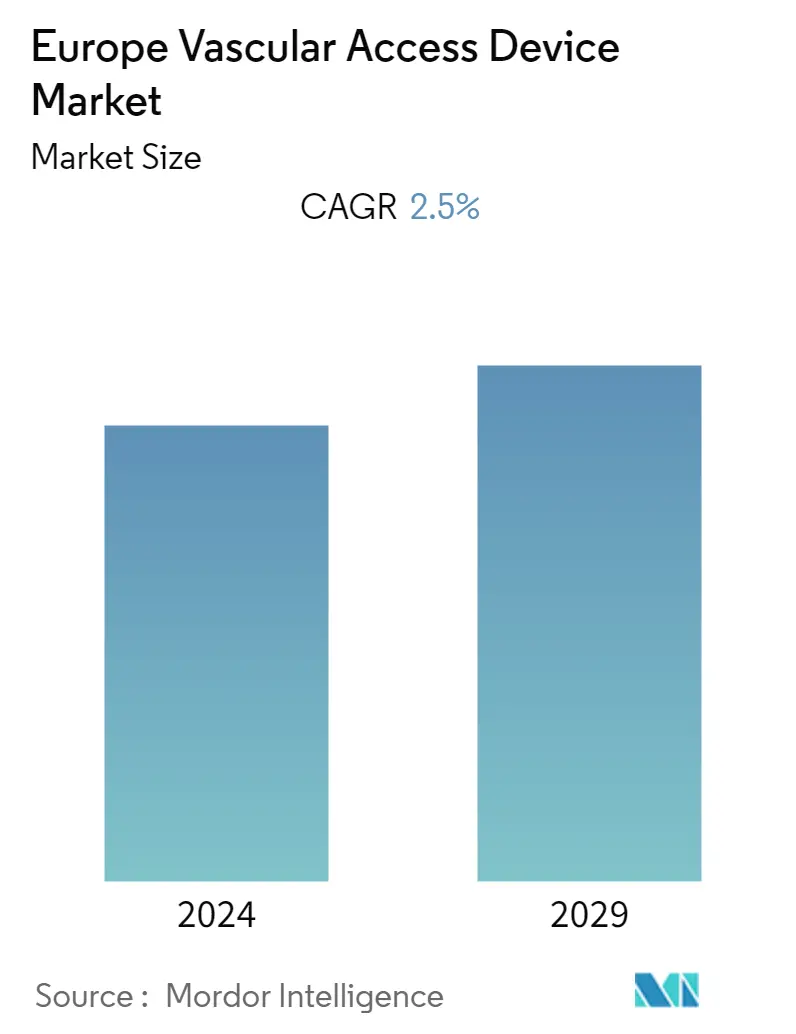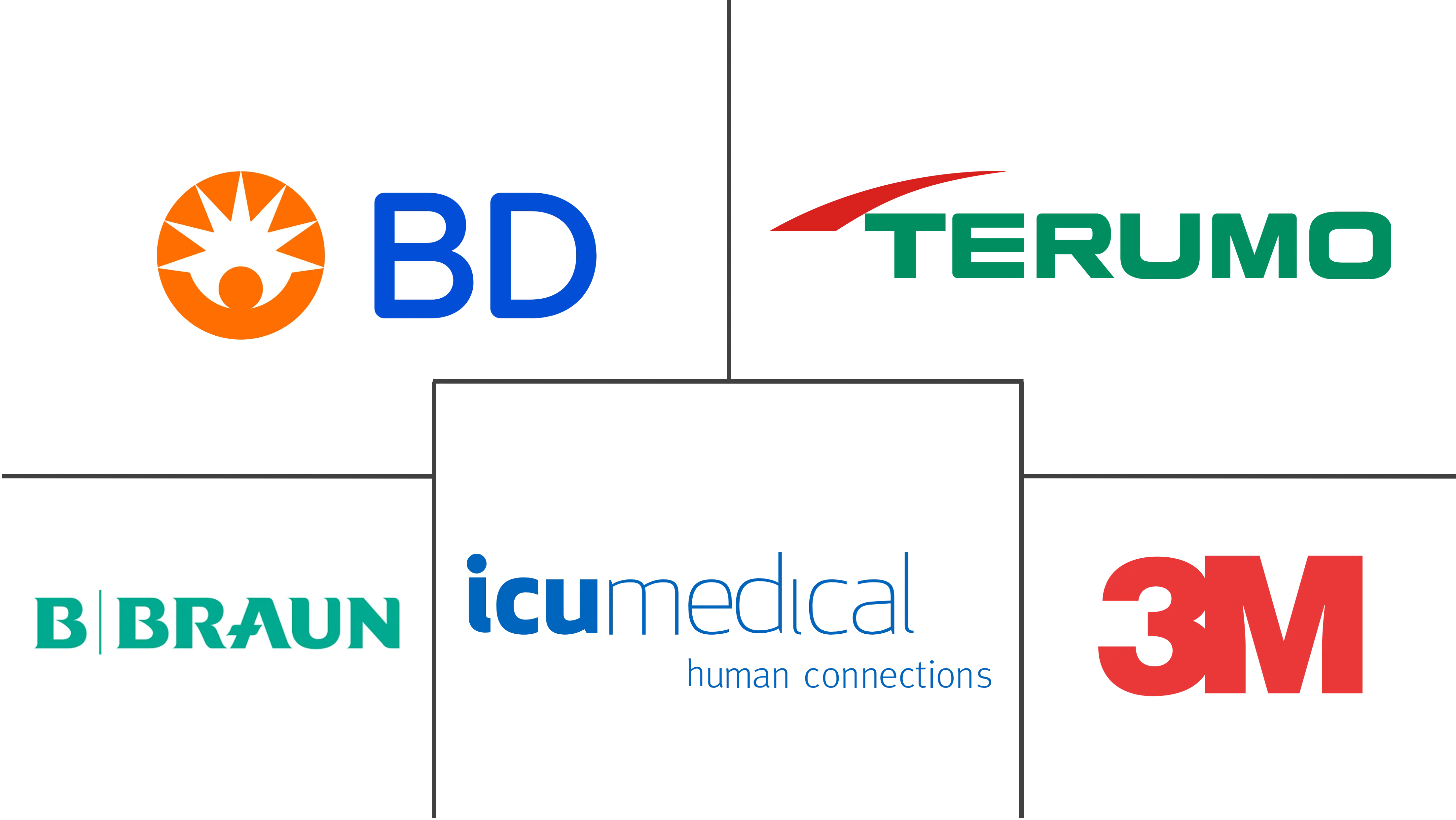Market Size of Europe Vascular Access Device Industry

| Study Period | 2019 - 2029 |
| Base Year For Estimation | 2023 |
| Forecast Data Period | 2024 - 2029 |
| Historical Data Period | 2019 - 2022 |
| CAGR | 2.50 % |
Major Players
*Disclaimer: Major Players sorted in no particular order |
Europe Vascular Access Device Market Analysis
The Europe vascular access device market is expected to register a CAGR of 2.5% over the forecast period.
- The massive volume of COVID-19 patients and the lockdown disrupted the diagnosis and treatment of non-COVID diseases. The increasing adoption of devices that were used to treat COVID-19 patients in intensive care consequently decreased the adoption rate of other devices. This was mainly due to the postponement or cancellation of procedures and surgeries during the pandemic.
- For instance, according to the study published in the Clinical Kidney Journal in April 2022, an increase in the use of central venous catheters (CVCs) was observed in comparison to prosthetic arteriovenous fistula (AFVs). The study's main objective was to investigate how the COVID-19 pandemic affected the development of vascular access devices, central venous catheter (CVC)-related hospitalizations, and complications in hemodialysis patients dialyzed in 16 Spanish hemodialysis units across three distinct geographic areas. When compared to a pre-COVID-19 period, a decrease in hemodialysis sessions was observed. However, the number of COVID-19 patients decreased in the post-pandemic phase, which led to the resumption of vascular surgeries and treatment, which enabled the market to grow at a steady pace in Europe. Thus, the COVID-19 pandemic adversely impacted the market in its preliminary phase in Europe. However, the market resumed its normal growth pace in the post-pandemic phase with the resumption of vascular disease treatment and increased vascular procedures in Europe and is expected to continue the upward trend over the forecast period.
- Factors such as the growing prevalence of chronic disease, an increasing number of chemotherapy procedures with high hospitalization rates, rising use of vascular access devices among pediatric patients, and growing initiatives from the European authorities are likely to drive the market growth positively.
- Over the past decade, there has been a rise in the prevalence of several chronic diseases that need vascular access treatment. Some of the major chronic diseases include cancer, kidney failure, and heart disease, among others within the European region. For instance, according to the research study published by the NCBI in October 2021, a high burden of peripheral vascular diseases was observed in the European region in 2021. Such an increase in the patient population is ultimately boosting the growth of surgeries within the region, thereby driving the demand for vascular access devices. Furthermore, according to the International Diabetes Federation (IDF), in February 2022, over 4,470,300 adults were reported to have diabetes out of the total adult [population in Italy, which was equivalent to a prevalence rate of 9.9%. It also stated that over 1.2 million children and adolescents aged 19 years or less were reported to have type 1 diabetes. Also, as per the data published by the International Agency for Research on Cancer (IARC) in 2023, the cases of cancer are expected to increase in Germany in the coming years, with 21.9 million cancer cases in 2025 and 24.6 million cancer cases in 2030. Such an increasingly high burden of cancer is anticipated to bolster the volume of chemotherapy, which in turn is expected to increase the demand for vascular access devices for the administration of drugs, fluid, and nutrition. Thus, considerable market growth is expected over the forecast period.
- Moreover, the recent developments by the market players have increased the penetration of vascular access devices in the European region; for instance, in September 2022, Delta Med Group, an Italy-based vascular access device for oncology and analgesic therapies, signed a strategic partnership with Pentaferte to compete in the European infusion medical device market. Similarly, in September 2021, Medtronic PLC received CE Mark approval for its radial artery access portfolio, which includes the Rist 079 Radial Access Guide Catheter and Rist Radial Access Selective Catheter. Also, in July 2021, Vivasure Medical launched its development program for PerQseal Blue, the new investigational sutureless and fully absorbable large-bore venous vessel closure following percutaneous cardiovascular procedures. PerQseal is currently available to physicians in Europe for use in novel transcatheter endovascular procedures that require large-bore arterial vessel access.
- Therefore, owing to the increasing burden of chronic diseases such as cancer, cardiovascular diseases, and diabetes and strategic initiatives by the key players, the market is expected to show significant growth over the forecast period.
- However, risks associated with catheter usage, stringent regulations, and product recalls are expected to hinder the market's growth over the forecast period.
Europe Vascular Access Device Industry Segmentation
Vascular access devices (VADs) are inserted into the veins for diagnostic and therapeutic reasons, such as blood sampling, central venous pressure readings, administration of medication, fluids, total parenteral nutrition (TPN), and blood transfusions. These are inserted peripherally or centrally.
The Europe vascular access device market is segmented by device type (central vascular access devices (peripherally inserted central catheters, percutaneous non-tunneled catheters, and other central vascular access devices) and peripheral vascular access devices (peripheral catheters, midline catheters, and other peripheral vascular access devices))), by application (administration of drugs, administration of fluid and nutrition, diagnostics and testing, and other applications), by end-user (hospitals and clinics, diagnostic centers and other end-users) and geography (Germany, United Kingdom, France, Italy, Spain, and Rest of Europe).
The report offers the value (in USD) for the above segments.
| By Device Type | |||||
| |||||
|
| By Application | |
| Administration of Drugs | |
| Administration of Fluid and Nutrition | |
| Diagnostics and Testing | |
| Other Applications |
| By End-User | |
| Hospital/Clinic | |
| Diagnostic Centers | |
| Other End-Users |
| Geography | |
| Germany | |
| United Kingdom | |
| France | |
| Italy | |
| Spain | |
| Rest of Europe |
Europe Vascular Access Device Market Size Summary
The Europe vascular access device market is poised for steady growth, driven by the increasing prevalence of chronic diseases such as cancer, kidney failure, and cardiovascular conditions. The market experienced initial setbacks due to the COVID-19 pandemic, which led to a shift in focus towards devices used in intensive care, thereby delaying the adoption of other vascular access devices. However, as the pandemic's impact waned, the resumption of vascular surgeries and treatments facilitated a return to normal growth trajectories. The market is further bolstered by the rising number of chemotherapy procedures, the growing use of these devices among pediatric patients, and supportive initiatives from European authorities. Strategic partnerships and product innovations by key players are also enhancing the penetration of vascular access devices across the region.
Germany is expected to be a significant contributor to the market's expansion, attributed to its large geriatric population and the high incidence of cardiovascular diseases. The demand for vascular access devices is anticipated to rise, driven by the need for surgical treatments and the administration of drugs, fluids, and nutrition. Recent developments, such as acquisitions and new product launches by market players, are expected to further strengthen the market's presence in Germany. Despite challenges like risks associated with catheter usage and stringent regulations, the market is projected to experience considerable growth, supported by the high efficacy and safety of vascular access devices in managing chronic conditions.
Europe Vascular Access Device Market Size - Table of Contents
-
1. MARKET DYNAMICS
-
1.1 Market Overview
-
1.2 Market Drivers
-
1.2.1 Growing prevalence of Chronic Disease
-
1.2.2 Increasing Number of Chemotherapy Procedures with High Hospitalization Rates
-
1.2.3 Rising Use of Vascular Access Devices among Paediatric Patients
-
-
1.3 Market Restraints
-
1.3.1 Risks Associated with Catheter Usage
-
1.3.2 Stringent Regulations and Product Recalls
-
-
1.4 Porter's Five Forces Analysis
-
1.4.1 Threat of New Entrants
-
1.4.2 Bargaining Power of Buyers/Consumers
-
1.4.3 Bargaining Power of Suppliers
-
1.4.4 Threat of Substitute Products
-
1.4.5 Intensity of Competitive Rivalry
-
-
-
2. MARKET SEGMENTATION (Market Size by Value - USD)
-
2.1 By Device Type
-
2.1.1 Central Vascular Access Devices
-
2.1.1.1 Peripherally Inserted Central Catheters
-
2.1.1.2 Percutaneous Non-tunneled Catheters
-
2.1.1.3 Other Central Vascular Access Devices
-
-
2.1.2 Peripheral Vascular Access Devices
-
2.1.2.1 Peripheral Catheter
-
2.1.2.2 Midline Catheter
-
2.1.2.3 Other Peripheral Vascular Access Devices
-
-
-
2.2 By Application
-
2.2.1 Administration of Drugs
-
2.2.2 Administration of Fluid and Nutrition
-
2.2.3 Diagnostics and Testing
-
2.2.4 Other Applications
-
-
2.3 By End-User
-
2.3.1 Hospital/Clinic
-
2.3.2 Diagnostic Centers
-
2.3.3 Other End-Users
-
-
2.4 Geography
-
2.4.1 Germany
-
2.4.2 United Kingdom
-
2.4.3 France
-
2.4.4 Italy
-
2.4.5 Spain
-
2.4.6 Rest of Europe
-
-
Europe Vascular Access Device Market Size FAQs
What is the current Europe Vascular Access Device Market size?
The Europe Vascular Access Device Market is projected to register a CAGR of 2.5% during the forecast period (2024-2029)
Who are the key players in Europe Vascular Access Device Market?
Smiths Medical, Inc., B.Braun Melsungen Ag, Prodimed, Becton, Dickinson and Company and Teleflex Incorporated are the major companies operating in the Europe Vascular Access Device Market.

